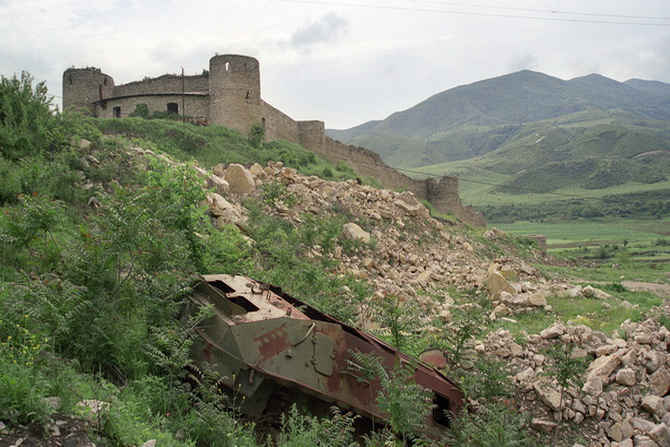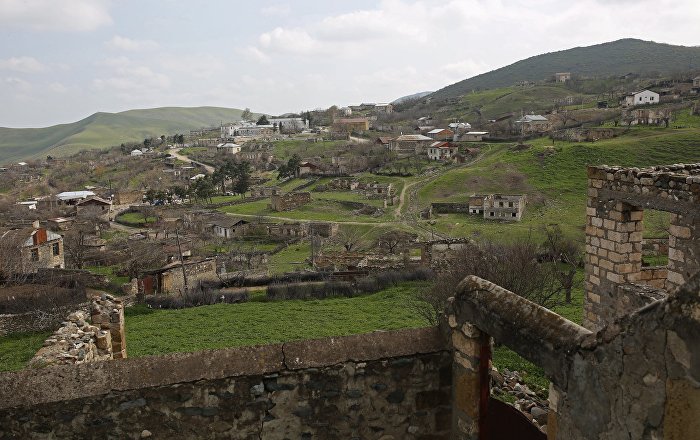...The Major General Georgy Septa told me about the events in Nagorno-Karabakh as a witness. In the period from June 1983 to March 1988, he has led the KGB Department of the Autonomous Region, which served Stepanakert, five districts of regional subordination, and two of republican subordination with the Azerbaijani and Kurdish populations. It is the first time when he recalls these times in public.
- During the period of the establishment of Soviet power in the Caucasus the border demarcation between Azerbaijan and Armenia were revised as a result of a number of subjective reasons. In the future it has sown seeds of discord and war.
The situation in Nagorno Karabakh worsened on February 20, 1988. An extraordinary session of the regional Council of People's Deputies was held on this day in the administrative center of the Nagorno-Karabakh Autonomous Oblast (NKAO) in Stepanakert, which raised the issue of the enclave's transfer to Armenia. The regional KGB department's employees were instructed from Moscow not to interfere in this process. Then state security agencies still had the power, and if the command had been given to prohibit the discussion of such agenda, it is quite possible that the session would not be held. However, it was advantageous and desirable for someone.
The Presidium of the Supreme Council of Azerbaijan assessed the event only as a petition of a group of local MPs. And it was declared inadmissible, contrary to the interests of the Armenian and Azerbaijani population of Nagorno-Karabakh and Azerbaijan, therefore was rejected. Some time later, the Supreme Council of Armenia in response to the re-circulation of the Regional Council of NKAO adopted a unilateral decision on the inclusion of Nagorno-Karabakh to the Armenian SSR.
This public circulation of the regional council's deputies has been a benchmark, which launched an open phase of geopolitical confrontation between Armenia and Azerbaijan on the Karabakh issue. It is preceded by many years of work aimed at ideological justification for rejection. It intensified with the onset of perestroika, which emancipated a multi-ethnic community, at the cost of destroying the all-union political space it returned the concept of national sovereignty and the right to self-determination to Soviet republics. However, their implementation has plunged the country into ethnic strife. From the Armenian side is was a revision of national boundaries in terms of "historical right", which caused disenfranchisement of hundreds of thousands of people. The energy of the separatist movement's organizers turned out to be more devastating than the Kremlin's perestroika policy.
Mikhail Gorbachev's assessment of the situation was also not original: he merely repeated theoretical developments of various kinds of political babblers, which appeared just in the period of perestroika, when the word "analyst" has just entered into circulation.

According to operational information, which has been systematically sent from the KGB department of the autonomous region to the higher Party organs and the KGB, during 1987 there was almost open propaganda work in Armenia and among the Armenian population of Nagorno-Karabakh, which was 74% of the total population.
The first deputy chairman of the KGB F. Bobkov, actively responded to the information received from the department of the KGB for the autonomous region, noting that "already for two years we have warned about the coming conflict between Armenia and Azerbaijan." Flowing his initiative, on behalf of the Secretary of the Central Committee of the CPSU E. Ligachev, the brigade was sent to Armenia and Nagorno-Karabakh, which confirmed that there are dangerous processes in the Caucasus, which require urgent actions. The issue was brought up for discussion in the secretariat of the Central Committee of the CPSU. However, all conclusions and proposals of the brigade were removed or smoothed out - no one wanted to acknowledge the existence of conflicts on a national basis in the country.
Duality and contradictory of the Kremlin leadership's political line was quite evident in the period preceding the sad events. During 1987 there were numerous appeals on the territorial issue to the Central Committee of the CPSU and the USSR Supreme Soviet in the absence of an unequivocal response, which encouraged the public promotion of territorial claims. Moreover, contrary to the declared openness, Moscow didn't discuss this topic with the leadership of Azerbaijan, it was officially not informed about any appeals from the Armenian side.
It should be noted that there were interethnic Azerbaijani-Armenian marriages, although rare, in Nagorno Karabakh. But in Baku, where about 250 thousand Armenians live, there were a lot of such unions.

Territorial claims were not a surprise to the party and state leadership of the USSR. Moreover, the Kremlin possessed information about separatism, about what was going on in Nagorno Karabakh and around it, about what was coming. Proponents of separatism, being consulted in the Kremlin's offices, inserted radical slogans into the democratic rhetoric of perestroika.
However, the first public performances and mass demonstrations calling for the transfer of Nagorno-Karabakh to Armenia have began in November 1987 in Yerevan. It was a kind of rehearsal, a signal for the deployment of a territorial conflict. However, this fact has been also ignored by Moscow.
In the beginning of February 1988, a blind unrest among the Armenian population of the autonomous region has reached a critical point and, as if on cue, spilled on the streets of Stepanakert. The first public rally, about which they informed in detail and in advance the Nagorno-Karabakh Regional Committee of the Party, the Communist Party of Azerbaijan and the KGB, was held on February 12. From that moment on, rallies and demonstrations demanding the transfer of Nagorno-Karabakh to Armenia were periodically held for the subsequent period, gradually dragging into the confrontation more and more people from both parties.
It should be noted that there were no operating churches and mosques in Nagorno Karabakh, unlike Armenia and Azerbaijan, clerics of which could have a corresponding impact on the evolving situation.
Some politicians believe that the movement for the transfer of Karabakh to Armenia emerged and exists only among Armenians living in Nagorno-Karabakh. The attempt to present them as a single side opposing Azerbaijan was dictated by the persistent desire to present the conflict as the Azerbaijani-Karabakh one, not as the Armenian-Azerbaijani conflict. Meanwhile, it is difficult to hide the irredentist nature of the pan-Armenian movement for the seizure of Nagorno-Karabakh, if we bear in mind its essence consisting of the only base - an ethnic affinity of the population living on its territory.
The events in Yerevan and Stepanakert have created a very tense situation in the relations around the perimeter of the direct interaction between the Armenian and Azerbaijani population. It caused the first "internal" refugees Azerbaijanis from Nagorno-Karabakh. The situation around the Azerbaijani population in Armenia, where there were hundreds of refugees, was dramatic. But it was only the initial stage of the ethnic tragedy which still could be stopped.
Along with the neutral position of "the architects of perestroika" the movement for reunification was continued through attacks against the civilian population. Violence spawned counter-violence. And after some time the conflict has become irreversible.
Later there were Sumgait and Baku, and then - the real clashes ...
What does the Karabakh story mean? Both then and today, we do not know how to solve such conflicts. We do not know the answer to a fundamental question: what is more important, the national sovereignty or the right of people to self-determination? But it is the essence of the ethnic conflict, degenerated into a confrontation between the once fraternal republics. For a long time they explained ethnic conflicts and separatist sentiments by a miserable level of existence of some people in comparison with others. But we see that separatism, hatred and territorial disputes appear in well-nourished countries as well.
When you see faces distorted by hatred, you think: national consciousness is the strangest phenomenon. How much cruelty and aggression it has. Performances of national-patriots make you feel weird. You look at the seething volcano of nationalism - and cannot grasp the whole picture, which is opening in front of you. The whole territory is already divided. And getting into a dispute about who owns what and who should own it instead, is not just dangerous, but pointless. One can almost always find a reason for the national infringement. Today one starts a dispute about who should own the territory, an tomorrow - the war. There is no other way...
* * *
Georgy Septa served in the KGB since 1968. In the period from June 1983 to March 1988 he has led the KGB in NKAO. In July 1988, due to a sharp worsening of the inter-ethnic situation in Baku the KGB leadership decided to transfer him to the management of the State Security in the Stavropol region. Then he went to a new federal structure - the tax police, which was just beginning to take shape. He was the first deputy head of the Russian Federal Tax Police Service in the Stavropol region. Georgy worked in the security bodies 28 years, in the tax police - 7 years. He has state awards, the rank of Major General, honorary officer of the tax police, was awarded arms with personalized engraving.






